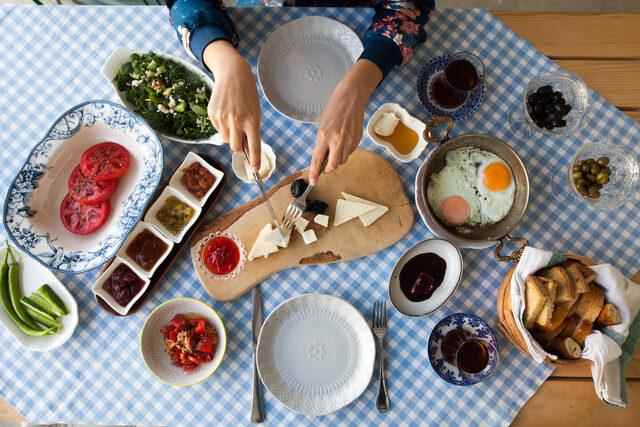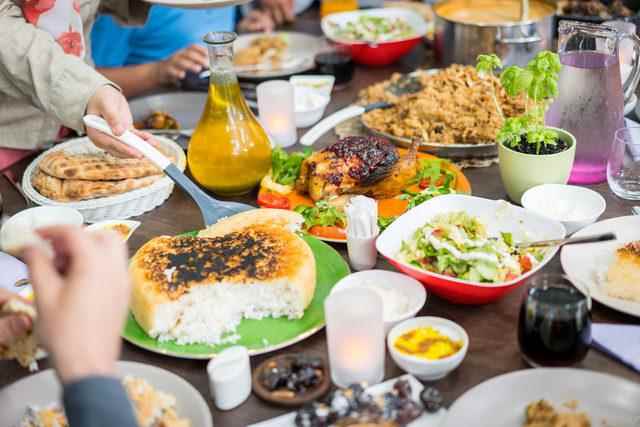During fasting hours when no food or drink is consumed, the body begins to use carbohydrates and fat stores stored in the liver and muscles after using all the energy from the foods consumed during the night. For most people, this is not bad, but those with chronic diseases such as diabetes, or pregnant and nursing mothers should consult their doctor before fasting. For those who want to lose weight, the month of Ramadan is an advantage to get rid of excess body fat stores. However, this advantage should be used with proper nutrition. Turning to sugary and fatty foods and drinks during iftar and sahur easily causes weight gain.
EXERCISE IMMEDIATELY BEFORE OR TWO HOURS AFTER IFTAR
Weight loss can also be lost during Ramadan when a diet program is formed with sahur, iftar and snacks made 2 hours after iftar, and exercises done just before or 2 hours after iftar. The important thing is to eat as much as the person needs and rich in foods that do not increase the blood sugar level quickly. While fasting, attention should be paid to protein sources and vegetable consumption. Suhoor and iftar menus that will be created in an adequate and balanced way will keep the metabolic rate alive. Weight gain can be prevented with regular exercises or walks just before or 1-2 hours after iftar.
MEET YOUR SWEET NEED WITH FRUITS
People who want to achieve weight control should definitely meet their sweet needs with fresh fruits during this period, and sugary foods should be limited to once a week. Consumption of foods rich in fat, especially animal fats, fatty meats or pastries with margarine/butter should be reduced. Instead of frying food, other cooking methods such as baking, boiling or grilling should be preferred. Consumption of white bread, rice, pasta, whole wheat bread instead of pita bread, pita made with whole wheat flour, bulgur wheat, whole wheat pasta makes it easier to provide portion control by keeping you full for a long time thanks to its rich fiber and nutritional value.
CONSUME FOODS WITH HIGH FIBER AND NUTRITIONAL VALUE IN SAHUR
In order for the metabolism to continue to work properly, sahur must be made. Sahur meal can be thought of as breakfast. Good quality carbohydrate sources such as bread and pita bread made with whole wheat flour, oat-based cereals, which will keep blood sugar level in balance, with high energy and fiber content, and rich in protein (e.g. eggs, milk and dairy products) and healthy fats (e.g. ; oil seeds, olive, avocado) foods should be preferred.

DO NOT CONSUME SUGAR, Caffeinated BEVERAGES AND SALT FOODS
At sahur, at least 500 ml of water should be drunk. In addition, water intake can be increased by consuming foods with a high water content. Vegetables and fruits that are high in both fiber and water, such as cucumbers and tomatoes, should be added to the meal. Caffeinated and sugary drinks such as tea and cola should be avoided during sahur. These drinks can cause more frequent urination and more water loss. Likewise, delicatessen products, salty cheese, olives, etc., which will cause water to be thrown out of the body. Avoid foods that are too salty.

Take a 15-minute break between soup and main course
Fasting can be broken with 1 glass of water and optionally 1 date or olive. Afterwards, it can be continued with the soup for a light start. There must be a 15-minute break before moving on to other meals. In order to avoid stomach ailments, it should be fed slowly and in appropriate amounts. In general, iftar, fried and processed foods rich in fat or sugar should be avoided.
MOVE LOTS AFTER IFTAR
Sweets that are frequently consumed during Ramadan contain a lot of sugar. Consuming sweets regularly after each iftar can cause weight gain. Dessert needs can be met by consuming fruit 1 hour after iftar. Any fruit that is in season, such as pears, apples, apricots, that contains water or has high fiber content according to the season and will contribute to the regular functioning of the intestines can be consumed. After iftar, you should move as much as possible, go for a walk regularly or try to increase the level of physical activity with exercises that can be done at home.
MUST FOR 2 LITER WATER
Most people who fast during Ramadan experience headaches, fatigue and loss of concentration, intestinal problems such as constipation, dehydration (water loss) that can cause edema in the body. The body cannot store water. Therefore, during fasting, the kidneys try to conserve as much water as possible by reducing the amount lost in the urine. But every time you go to the toilet, breathe and sweat, the body continues to lose water. Depending on the weather and the length of the fast, the water lost during the day while fasting does not cause any health problems if an average of 2 liters is drunk between iftar and sahur.
SAMPLE SAHUR MENU
- Egg and vegetable omelet
- feta cheese
- Unsalted olives or walnuts
- Lots of greens, tomatoes, cucumbers, etc.
- whole grain bread
- 1 glass of milk or kefir or boiled egg
- 1 cup of oatmeal with yogurt
- 1 handful of almonds/hazelnuts/walnuts etc.
- 1 serving of fruit
SAMPLE IFTAR MENU
- A creamy soup, grilled/boiled/baked meat/chicken/fish/turkey
- Whole grain bread or bulgur pilaf with yoghurt / ayran / tzatziki or a soup without cream
- Legumes or vegetables, whole grain bread or bulgur pilaf, yogurt/ayran/tzatziki
Snack after iftar;
1 palm-sized fruit and mixed raw nuts

